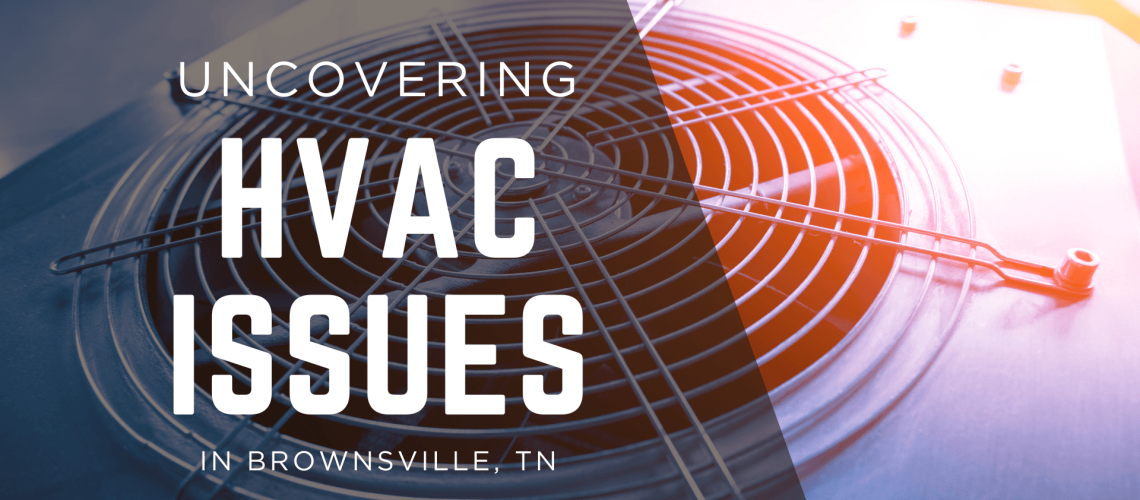When you’re buying a home in Brownsville, Tennessee, you expect the air to feel comfortable the moment you walk inside — warm in the winter, cool in the summer, and fresh year-round. But comfort can be deceiving. The heating and cooling system might run quietly now, while hiding problems that could cost thousands of dollars later.
As a home inspector serving Brownsville and the surrounding West Tennessee area, I often find that HVAC systems tell a story about how well a home has been maintained. Some issues are obvious the moment you open the closet or attic hatch; others only reveal themselves through testing, age identification, or airflow patterns throughout the home.
Let’s take a closer look at the most common HVAC problems I encounter during inspections — and what they mean for homebuyers in our region.
Aging or Outdated Equipment
Many homes in Haywood County still rely on systems installed 15 to 20 years ago. While older equipment can continue to run for decades with regular servicing, efficiency tends to drop sharply after the ten-year mark. Coils corrode, blower motors wear down, and refrigerant types become obsolete.
One clue I look for is the manufacture date on the nameplate of the condenser or furnace. If the system was installed before 2010, it likely still uses R-22 refrigerant — a chemical that’s been phased out and is now extremely expensive to replace. When a leak occurs, repair may no longer be economical. For a buyer, this doesn’t necessarily mean walking away from a good home, but it does mean budgeting for future replacement.
Dirty Filters, Clogged Coils, and Restricted Airflow
Something as simple as a dirty air filter can tell a lot about how a system has been treated. When filters aren’t changed regularly, dust and debris begin to accumulate on evaporator coils and inside ductwork. This not only reduces airflow but causes the system to run longer and harder to reach the same temperature — raising energy bills and accelerating wear on parts.
During inspections, I often find filters that haven’t been changed in months, or in some cases, years. Ducts may show layers of dust or even evidence of past rodent activity. Airflow imbalances between rooms can indicate blocked vents or damaged duct runs hidden behind walls or under floors. These are the sorts of maintenance issues that go unnoticed until an inspection catches them.
Improper Installation or Modifications
It’s not uncommon for me to find systems that were replaced by homeowners or unlicensed contractors without proper permits. In Brownsville’s older houses — especially those built before the 1980s — ductwork may have been added later or pieced together from multiple upgrades over time.
Improperly sized ducts or equipment can lead to short cycling, temperature inconsistencies, or premature compressor failure. Sometimes return vents are undersized, causing the system to struggle to “breathe.” I’ve seen new HVAC units installed in crawlspaces without adequate clearance or drainage — setups that might technically work but don’t comply with manufacturer or code standards.
A proper installation isn’t just about comfort; it’s about efficiency, safety, and longevity. Buyers should always ask for documentation on recent replacements or repairs and confirm the work was performed by a licensed HVAC technician.
Condensation and Drainage Problems
Moisture is one of the most damaging forces in a home, and HVAC systems are one of its main sources. In Brownsville’s humid climate, condensation can form quickly on coils, drain lines, and even air handler cabinets if drainage isn’t properly maintained.
A clogged condensate line or a missing secondary drain pan in the attic can easily lead to ceiling stains or drywall damage. During inspections, I always check for visible rust around the drip pan and ensure that the drain line exits properly to the exterior. A properly installed float switch can prevent overflow, but many systems lack this simple protection.
If you see water stains around ceiling vents or near the air handler, it’s a sign that condensation hasn’t been draining correctly — and it’s time for a service visit.
Inadequate Insulation and Duct Leaks
Even a well-functioning HVAC unit can’t keep up if the air it produces leaks out before reaching the rooms. Older ductwork often separates at seams or loses its insulation, especially in attics and crawlspaces where temperature extremes are common.
Leaking ducts can waste up to 30% of conditioned air, meaning you’re paying to heat or cool the outdoors. During inspections, I look for disconnected joints, missing mastic sealant, and uninsulated flex duct. This type of inefficiency not only drives up utility costs but also makes it difficult to maintain even temperatures throughout the home.
Homeowners can significantly improve performance by having their ductwork sealed and insulated by a professional. It’s one of the most cost-effective energy upgrades available.
Lack of Regular Maintenance
Many HVAC issues stem from simple neglect. Units that haven’t been serviced annually are more likely to experience breakdowns, refrigerant leaks, and thermostat malfunctions. I always advise buyers to ask for maintenance records — something as small as a sticker showing service dates can tell a lot about how the system has been cared for.
In homes where no records exist, it’s wise to schedule a comprehensive tune-up immediately after purchase. Preventive care is far cheaper than emergency repair, and a professional cleaning will extend the system’s life.
The Bottom Line
In Brownsville, where summer humidity and winter cold both make strong demands on your HVAC system, it’s essential to know what you’re buying. An aging or poorly maintained system can still appear to function normally on the day of inspection — but may be one heatwave or cold snap away from failure.
A professional home inspection provides more than just a quick visual check. I verify system operation, examine ductwork, check filters, look for leaks, and document the age and condition of key components. My goal is to help buyers understand the true state of the home’s mechanical systems, not just whether the air blows cold.
If you’re purchasing a home in Brownsville or anywhere in West Tennessee, a detailed inspection from Upchurch Inspection ensures you’re fully informed — and that the comfort you feel on day one will last for years to come.
📞 Schedule Your Brownsville Home Inspection Today
Serving Brownsville, Dyersburg, Covington, and surrounding West Tennessee communities, Upchurch Inspection provides certified home inspections, HVAC evaluations, and specialized testing for mold, radon, water quality, and sewer systems.
📞 Call (901) 350-8885 or visit UpchurchInspection.com to schedule your inspection today.


